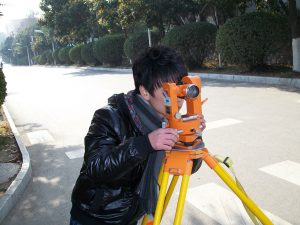Becoming a Surveyor in the USA
American Specific University Study– Taking an ABET (or similar) accredited course provides a great base. “We are a nonprofit, non-governmental agency that accredits programs in applied and natural science, computing, engineering, and engineering technology. 
ABET accreditation provides assurance that a college or university program meets the quality standards of the profession for which that program prepares graduates.
We accredit programs, not institutions. We provide specialized accreditation for post-secondary programs within degree-granting institutions already recognized by national or regional institutional accreditation agencies or national education authorities worldwide.
Our accreditation is voluntary, and to date, 4,307 programs at 846 colleges and universities in 41 countries have received ABET accreditation. Over 100,000 students graduate from ABET-accredited programs each year, and millions of graduates have received degrees from ABET-accredited programs since 1932”.
Find courses here.
Becoming a Surveyor
Unlike other countries, each state in the US has different requirements for becoming a surveyor. Each state has its own licensing board which is often referred to as the Board of Registration. Education requirements and experience requirements vary from state to state as well.
In Indiana (where our Brand Ambassador Ryan is from) for example you must have an associate’s degree with 27 credit hours in specific land surveying courses. You must work under the direct supervision of a Professional Surveyor (PS) for 2 years and then you can take the Surveyor Intern exam. Once that exam is passed there’s an additional 4 years working under a PS before you can sit for the PS exam. Once all of that has been completed you are able to practice on your own.
All states have some sort of combination of education and experience. Some require a Bachelor’s degree and 2 years of experience. A few states have a path to licensure where no education is required but you have to work under a PS for 10 years. For more information about the qualifications required by the respective states for designation as a Professional Surveyor, visit this site.
Becoming a Surveyor Worldwide
Extra Curricular: Gaining work experience is one of the most important things you can do. Not only does this show how keen you are to learn the skills needed for the job, it also tells you if the career is what you expected, which at this point you could alter your career path to suit something that is more suited to you.
If work experience isn’t an option for you, volunteering certainly is. Volunteering not only looks good on your CV, but it helps you get a grounding and gaining life skills. It does not have to be within the industry, any volunteering is valuable.
There are a wide variety of sectors and routes to go down in this industry. Nicely demonstrated in this image:

A great representation by Geospatial Jobs shows which sectors the Geospatial Graduates of today want to go into. There are so many options within each of these sectors too. Lots to explore and grow with as you gain more experience and opportunities. Further specialization can be made with further qualifications for career progression.
Challenges in recruitment in the sector: It is clear from the ongoing needs of the construction industry that there will be a significant shortfall in the number of suitably qualified individuals to take up posts in organizations working on the huge infrastructure projects that the UK will be embarking on over the next 10 to 20 years The shortfall in construction skills is mirrored in the supporting geospatial profession which provides the foundations to most of these projects so play a critical role.
“Both the University of East London and Newcastle University have seen a long-term trend of falling numbers of students applying to study specialist geospatial degree courses. The Design Engineer Construct! curriculum, which features geospatial engineering, has had its parity with GCSEs and A levels removed by the Department for Education, making it less viable for schools to offer”.
Solutions to the Challenges: The Industrial Strategy: Construction Sector Deal published in July 2018 refers to the investment of an additional £406m in maths, digital and technical education, helping to address the shortage of science, technology, engineering, and maths (STEM) skills. This will be a big boost to the geospatial industry as we are very much included in this and the digital aspect.
Kids often do not have an understanding of what the geospatial industry is. With a lack of applied activities in school even though they are learning the content. The major problem is that teachers, parents, and children do not know the career options available or the possible high earnings for those professionals that come with it. As mentioned previously the Design Engineer Construct is here to try and teach more about the opportunities within the industry to secondary school ages. In lower years Get Kids into Survey is trying to expose the industry in a fun way, including it in posters which are branching out into Q&As and lesson plans too. Schools are encouraged to have geospatial engineers and survey firms to come in to deliver assemblies and regularly engage with the kids. Lastly, the Adopt a School program from Class of Your Own partner’s construction firms (including geospatial engineering businesses) with schools offers site visit opportunities and hands-on demonstrations of geospatial equipment and software.
In the Geospatial Engineering Education report the Geospatial Commission is provided with a list of proposed changes and targets in order to help the industry progress. Some of these suggestions include: ensuring long-term funding is available for more apprenticeship-based learning, Geospatial academia, and research bodies are asked to work with industry and professional bodies to ensure opportunities are present to everyone, Geospatial academia and industry and professional bodies are asked to improve liaison with STEAM and geography teachers, and that careers information is available from a young age.

Advice for current students:
How do you ensure a job is right for you? “Knowing if a job is right for you is such a circumstantial question, I think. In my opinion, the most important thing is that you be interested in the core of the role. For me, it’s chatting with people/socializing, for surveyors, it may be geography, or math, or being outdoors. Surveying can see you in the middle of the bush, or on top of a 28-story high rise in the city, or hundreds of meters underground; this is great because there’s a branch for almost everyone. But you have to be excited, and love what you do” -Sarah Clark
Katie Holt explains “There are lots of exciting career choices in surveying – you could be involved in construction and helping to make sure projects are built correctly, in the right place or you could be using drones, laser scanners, and other instruments to produce plans and maps of areas. There are plenty of opportunities for varied work and travel within your country and overseas.”
Linking back to another blog by James Gibbs, he asked the question ‘What advice would you give to someone starting a geospatial career?’ in which five geospatial experts gave their advice. Some key messages that I took away from this were:
-Curiosity is key… ask those questions, dig deeper, and make connections. The more you show genuine interest and willingness to learn the further you will go.
-Technology is advancing at a rapid rate, which leads to never-ending opportunities where the only limit is your imagination! Especially in recent years the development of tools used in space, collecting data through environmental observations, navigation, and communications.
-Don’t be afraid to question how and why things are done in a certain way. New ideas come from new perspectives, that might just happen to be you!
-Your first job doesn’t need to be your final job. You are free to follow your interests when different and new opportunities present themselves.
